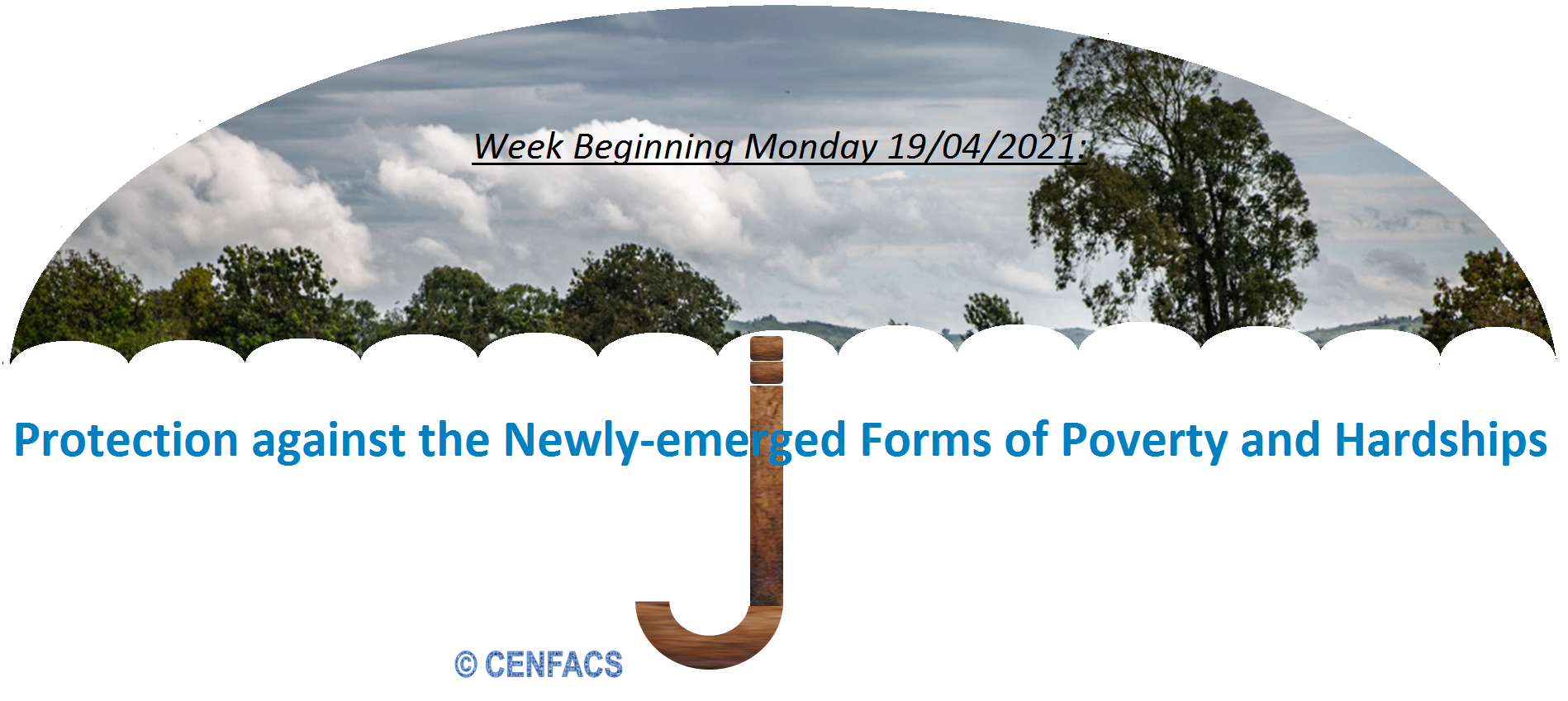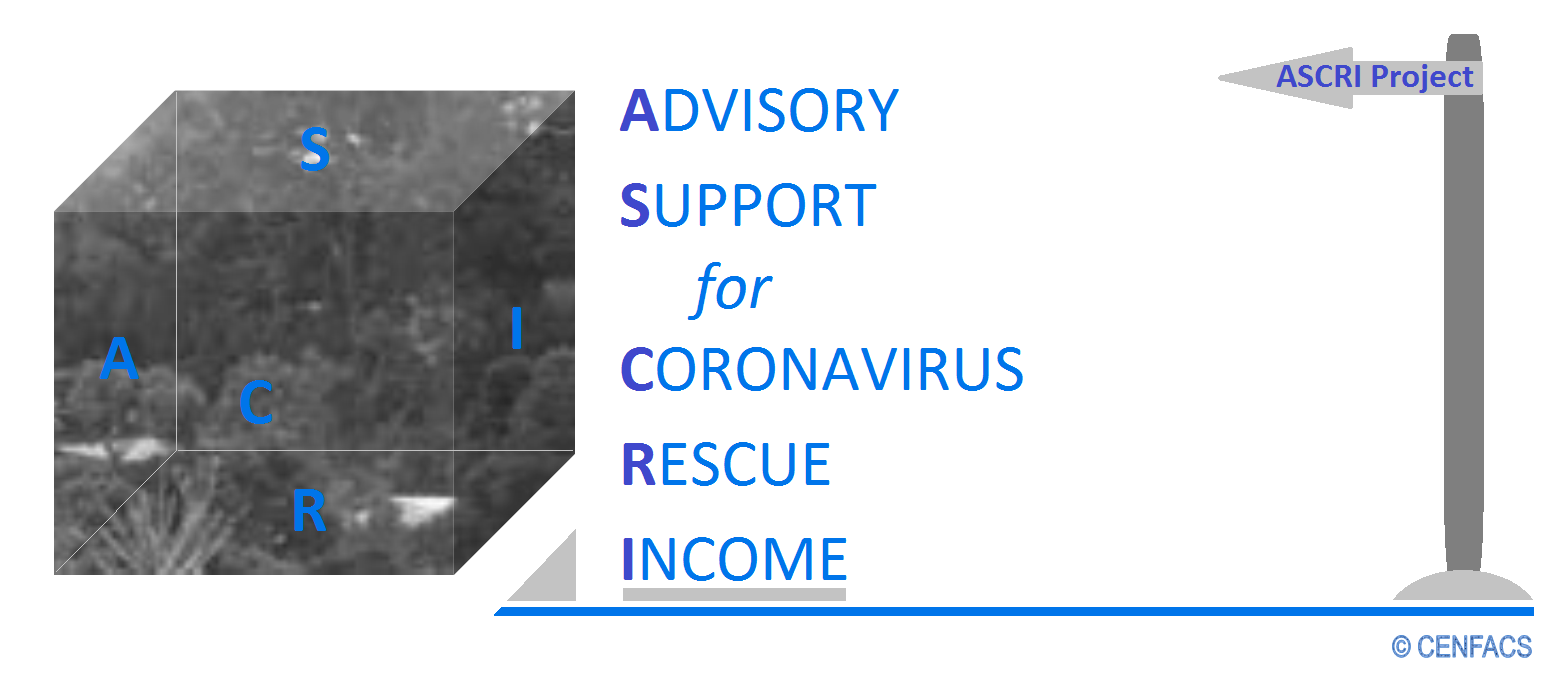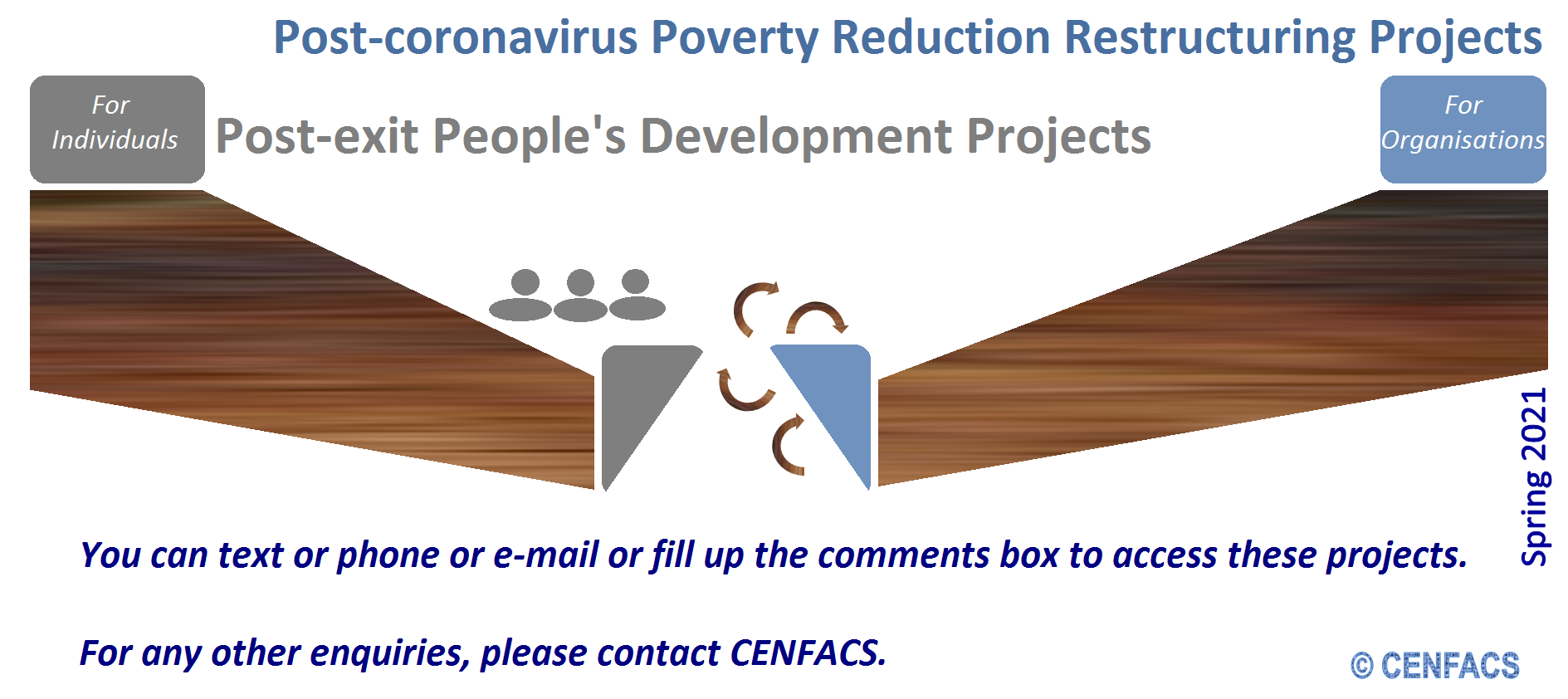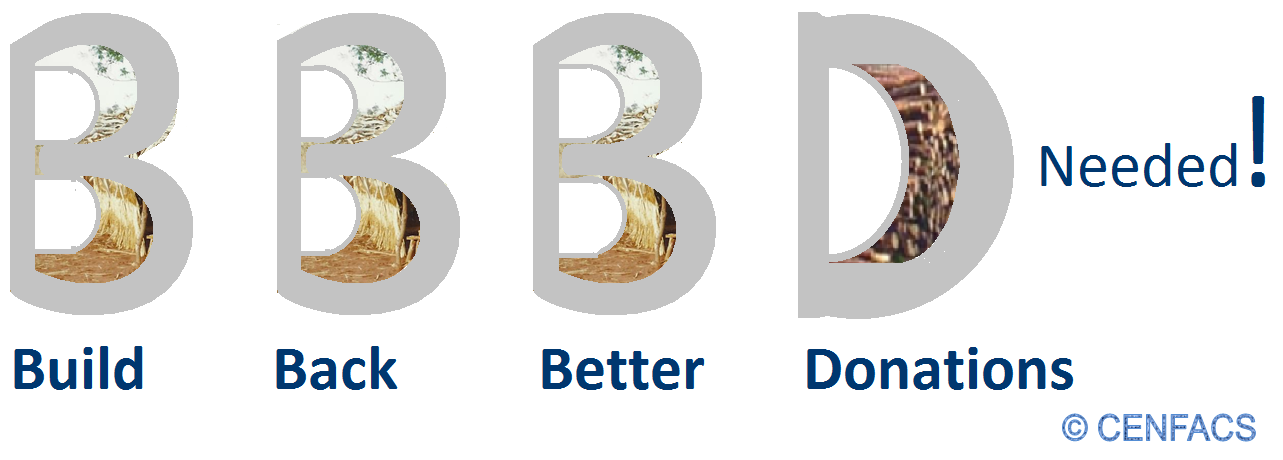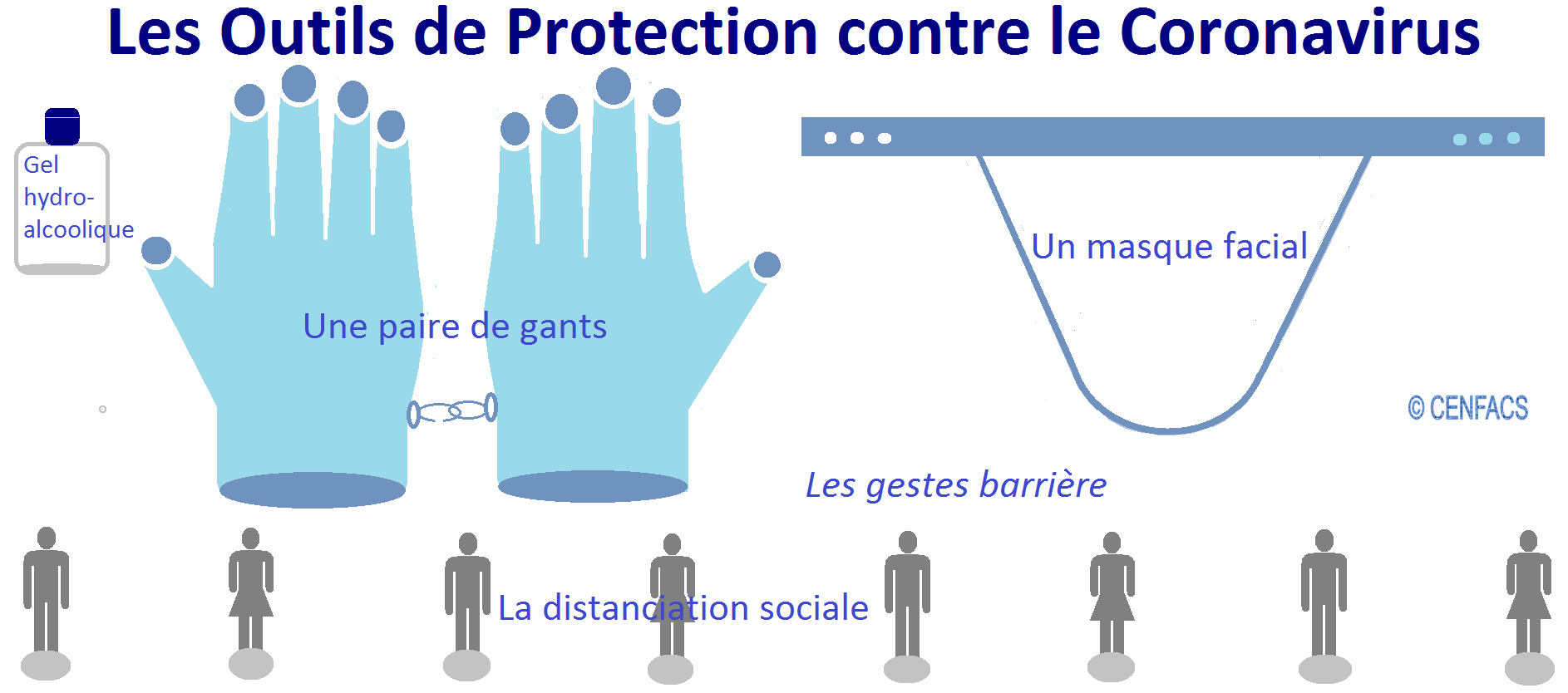Welcome to CENFACS’ Online Diary!
21 April 2021
Post No. 192
The Week’s Contents
• Protection against the Newly-emerged Forms of Poverty and Hardships (Protection Key Notes 3 for Week Beginning Monday 19/04/2021)
• Coming Next Tuesday 27/04/2021: Virtual Reflection with a Focus on Ring-fencing Protection for Women and Children to Become More Resilient and Vigilant to Future Risks and Crises
• Advisory Support for Coronavirus Rescue Income (ASCRI)
… And much more!
Key Messages
• Protection against the Newly-emerged Forms of Poverty and Hardships
(Protection Key Notes 3 for Week Beginning Monday 19/04/2021)
Our Month of Protection continues this week with the Protection Key Notes 3 that deals with the protection against the emergence and manifestations of new forms of lacks or deprivations experienced by a number of our community members during the enduring coronavirus time.
The new forms of lacks or deprivations are a situation of human failure in which a certain number of people in need has been struggling to meet the subsistence essentials of shelter, food, sanitation, etc. in order to maintain minimum levels of living. This failure is in itself an expression of lack of protection for those who are economically vulnerable at this very challenging time.
These needy people and new forms of lacks or inabilities to meet basic life-sustaining needs are further explained in the Main Development section of this post. In the said section, we will be mostly arguing about human protection against these new forms of poverty.
• Coming Next Tuesday 27/04/2021: Virtual Reflection with a Focus on Ring-fencing Protection for Women and Children to Become More Resilient and Vigilant in face of Future Risks and Crises
• • What is CENFACS’ Reflection Day?
CENFACS’ Reflection Day is a day to acknowledge the conditions of women and children in need, to reflect on attitudes and what can be done to improve the living conditions of women and children in need.
CENFACS’ Reflection Day is also a special eventful day to re-engage our mind set and spirit to deeply think about the fate of poor women and children, and engineer possible new solutions that can lift them out of poverty and hardships they are facing. At this time of enduring Covid-19, they may be facing sanitation poverty and associated hardships.
• • The 11th Edition of CENFACS’ Reflection Day
This year, the 11th Edition of our Reflection Day will be virtually run like last year. We shall keep it virtual since the fight against the coronavirus pandemic is still on. Because of the enduring coronavirus, we will not be physically gathering together on the day. Every participant will be reflecting from the location which is suitable for them (that is, like a virtual reality or remotely).
The 11th Edition is about processing thoughts and feelings about the conditions of poor women and children in terms of the best way of protecting themselves or protecting them.
It is about to enclose or reinforce protection for vulnerable and needy women and children to become more able to adapt and live despite future shocks and crises (like the coronavirus).
Although the Virtual Reflection Day (VRD) is about resilience building, it is also about managing future risks and harnessing women’s and children’s leverage of new opportunities for defence.
• • The need of protection
One may argue or question if this protection is really needed since no one knows these future risks and crisis or simply when they are going to happen.
To self-protect or protect lives no one needs a disaster first to happen. There is a say that prevention is better than cure. Protection is better before the disaster happens than waiting for a disaster to happen and react after.
In fact, one could learn from the mistakes made about the coronavirus as infectious disease. If preparation and protection were planned against the coronavirus, perhaps we would have minor impacts from it rather than those of a big scale like now. However, what are those future risks or crises that women and children need to think of for their own protection?
• • Future risks that need protection for women and children
To simplify the matter, we are going to refer the 16th edition of the World Economic Forum’s annual analysis – the Global Risks Report 2021 (1). In its report, the Forum categorises risks into the following types: economic, environmental, geopolitical, societal and technological ones. On the page 12 of this report, there are 10 top risks that are likely to happen and 10 top risks that may impact over the course of the next ten years.
Additionally, it is indicated in this report that further to the survey respondents’ results, the 10 top global risks by likelihood (from unlikely to very likely to occur over the course of the next ten years) are:
(1) extreme weather (2) climate action failure (3) human environmental damage (4) infectious diseases (5) biodiversity loss (6) digital power concentration (7) digital inequality (8) interstate relations fracture (9) cyber-security failure (10) livelihood crises
For the same survey respondents’ results, the 10 top global risks by impact (from minimal to catastrophic impact to occur over the course of the next ten years) are:
(1) infectious diseases (2) climate action failure (3) weapons of mass destruction (4) biodiversity loss (5) natural resource crisis (6) human environmental damage (7) livelihood crises (8) extreme weather (9) debt crisis (10) IT infrastructure breakdown
If any of these risks happen, they can affect the quality of life and well-being of women and children, especially the poor ones. Because of that, we can reflect on the ways of protecting women and children from these future risks.
For example, if there is a natural resource crisis, how can women and children protect themselves or how one can protect them? The Reflection Day can help to shine lights or simply have some thoughts and feelings about the answer on this question.
In the light of these future risks, there is therefore a need to improve resilience and vigilance of women and children should these risks become realities. In this respect, our Virtual Reflection Day will help in the following:
√ To provide ways of screening and analysing the early warning signals or signs of future threats and risks to protection so that women and children are not surprise by the course and speed of disastrous events like the coronavirus pandemic
√ To enable the identification and communication of the already-present, persistent and emerging risks
√ To mostly ring-fence protection in face of these potential or probable risks.
The above is the main menu of our Reflection Day. Besides this main menu, we shall have a side menu which is Reflection on the Effects of COVID-19 Threats on our Network for Protection in the process of building forward better together greener and cleaner.
• • Reflection on the Effects of COVID-19 Threats on our Network for Protection
Through this additional reflection exercise, we should be able to know whether or not the infectious disease like COVID-19 has made our network for protection stronger or weaker or unchanged. Alternatively, we can reflect on a new window of opportunities to network for protection that the coronavirus may have brought.
Briefly, this add-on activity will enable us to reset our system of networking for protection in the process of building forward together greener and cleaner.
To support or join the Reflection Day on the Protection of Women and Children, please contact CENFACS.
Under the Main Development section of this post, we have appended a timeline about CENFACS’ Reflection Day for your reference.
• Advisory Support for Coronavirus Rescue Income (ASCRI) to Help Those in Most Need
ASCRI, which is part of CENFACS’ Cube of Protection, is a non-face-to-face advice, support and information project to help those in most need and who lost their earning capacity or potential because of the destructive impacts of the enduring coronavirus pandemic on their incomes and lives.
The ASCRI project has a double objective:
(a) Helping deprived and vulnerable people impacted by Covid-19
(b) Supporting them through the alleviation of the associated social, environmental and economic hardships caused by the coronavirus crisis
The project, which will help them to improve their prospects for earning income again, is also a deterrent against side effects of losing income or earning capacity; effects such as mental, psychological and social breakdowns. Additionally, the project will help avoid reversal gains made by those in most need against poverty and hardships. In doing so, the project will assist them in better coping with undesirable change brought by Covid-19.
The ASCRI advice will be given in three keys areas:
# Advice to help stop the loss of income
# Advice to support response to the loss of income
# Advice on recovery measures to minimise the long term impact of Covid-19 after it ends, while helping them find new or alternative sources of earning income to prevent them from economic and financial collapse
Through this project, one can hope as outcomes, the following ones: self-confidence, self-esteem, hope, a newly survival strategy, develop new streams or sources of earning income again, build back better, etc.
To access and or gain the benefits of this project, please contact CENFACS.
Extra Messages
• Implementing Post-coronavirus Poverty Reduction Restructuring and Post-exit People’s Development Projects
From this week, we will start the implementation of the Post-coronavirus Poverty Reduction Projects (P-CPRRPs) and the Post-exit People’s Development Projects (P-EPDPs).
• • P-CPRRPs
P-CPRRPs, which are designed to work with organisations (particularly our Africa-based Sister Organisations), will be implemented in the context of the Programme of Building Back Better and Forward Together Greener and Cleaner and via our International Advice Service.
P-CPRRPs include the following:
managing changes, adaptation to new market developments, reorganisation of the system of poverty reduction production, and alignment to greenhouse gas emissions reduction goals and targets.
• • P-EPDPs
P-EPDPs, which are meant to support individuals (notably those making the CENFACS Community), will be carried out in the context of our Individual Capacity Development Programme and through our Community Advice Service.
P-EPDPs include the following:
promotion of living levels, self-esteem building and maintenance, and protection of human freedoms.
For those organisations or individuals in need who would like to work with CENFACS via either of these projects, they are advised to first contact CENFACS so that we can together carry out a needs assessment and draw a programme of work or action plan.
For any queries or enquiries about the above named two sets of projects, please do not hesitate to contact CENFACS.
• Coronavirus and Build Back Better Donations Needed!
The coronavirus pandemic and associated lockdowns have put serious pressure on the finances and other areas of operations of many organisations including ourselves.
We need donations to help those affected by both health crisis and lockdowns so that they can properly start the work of building back better.
We know that some of you have their income dropped because of the coronavirus pandemic and lockdown measures. However, for those who can, please do not hesitate to support as the need is still pressing and the stakes are still higher at this time.
You could be a life-saver or changer this Spring 2021.
We look forward to your support. Many thanks!
• YOUR SAY ON COVID-19 AND LOCKDOWNS as a New Poverty or New Opportunity
• • COVID-19 and lockdowns as damages and opportunities
In any crises, there are both damages and opportunities. This applies to the coronavirus as a health and economic crisis as well as to lockdowns as painkilling measures to stop the spread of the coronavirus disease.
One of the damages that the coronavirus has caused is the emergence of new poverty or new manifestations of poverty and hardships. Likewise, some of the measures taken to combat the coronavirus have accidentally resulted in the exacerbation of poverty and hardships for some sections of the population.
However, beyond or besides these damages, there could be opportunities not only for the well-off but also for those who are in need. There could be opportunity to bring to attention their living conditions. There could also be opportunity in the rebuilding process since there are calls for a recovery that is inclusive and for all.
So, as part of this week’s work on the protection against the new poverty, CENFACS would like to know from its members and followers if they consider themselves that the COVID-19 and some aspects of lockdown measures have been an experience of new poverty or new opportunity for them.
• • Sharing your COVID-19 and lockdowns experience
Those who think that COVID-19 has been an experience of new form of poverty for them; they can share with us their experience.
On the contrary, those who take a different view by contemplating that COVID-19 has been an experience of a new opportunity for them; they can as well share their experience in terms of the opportunity they have so far.
Those who believe that lockdowns or some aspects of lockdowns have been an experience of exacerbation of poverty or hardships for them; they can share with us their experience on this matter.
By contrast, those who feel that lockdowns or some aspects of lockdowns have brought some forms of opportunity for them; they can share with us their experience on this as well.
To share your experience about COVID-19 and lockdowns as a new poverty or a new opportunity; you need to text or phone or e-mail or complete the contact form on this website.
Main Development
• Protection against the Newly-emerged Forms of Poverty and Hardships
(Protection Key Notes 3 for Week Beginning Monday 19/04/2021)
The following makes up the contents of protection key notes 3: the changing face of poverty, change of the very nature of poverty, the new poor who need protection and protection of the new poor. Let us look at this makeup.
• • The changing face of poverty
The history of poverty in many places at different times tells us that poverty keeps on changing or if it has the same content its manifestations/presentation may be various. These changing face and manifestations are found at this time of the enduring coronavirus.
At this time of the enduring coronavirus and lockdowns, poverty may have shown its new face and or manifestations. This is to such an extent that one could argue that there are new forms of poverty. However, if one disagrees with this, let say that there are at least new manifestations of poverty. These new forms or manifestations could lead to a new message or paradigm shift in terms of the changing nature of poverty.
• • Change of the very nature of poverty
To speak about new forms of poverty, this requires a change of the very nature of poverty. It means that poverty as a lack of means or resources has undergone some transformations in such a way that it becomes something that has never been or seen before in a particular place or time or format. In other words, the essential character or outlook of poverty the way in which one knows it in particular place or at a specific time has changed.
If one observes what has currently happened in some places during this health crisis, one can argue that the coronavirus has perhaps created new poverty or new manifestations of poverty, while some measures of lockdowns may have fuelled the problem of poverty and hardships.
Likewise, if one takes into account the various signs pointed up by relative poverty indicators, one could argue that the magnitude of phenomenon of “lack” has been so deeper to the extent that one could think that there are emerging new forms of poverty. What are those forms or who are those new poor or new symptomatic to poverty.
• • Types of new poor who need protection
Like in any lacks (or diseases), some people will show mild symptoms, while others will have strong symptoms of lack. Others even could be asymptomatic as they may show manifestations of lack without really becoming poor. For those who have been really affected by the socio-economic impacts of the coronavirus and inappropriate lockdown measures to the extent that they become poor or their conditions of poverty become exacerbated; who are they?
They are as follows:
√ The new types of street beggars (amongst them are normal looking gentlemen and normal young girls)
√ Those who failed to meet the punitive terms and conditions of the coronavirus financial bailout programmes and policies
√ The new homeless who are in search of any secure refuge or corner in the local area to shield themselves because the town and shopping centre are locked down
√ The rejected by the system that is meant to count every body
√ Those who have been cut off from their network of support or service
√ Those who simply own nothing
√ The previously and relatively protected who lost their protection because of the coronavirus and lockdowns
√ Those who become socially and economically vulnerable because of the coronavirus and lockdowns
√ Those who are experiencing instability in social relations because of the coronavirus and lockdowns
√ The new digital, information and communication poor not having access to support/help
√ Those who have been caught in poverty trap because of social and physical distance measures that made life line services to move away from them
√ The least protected community groups and sections of the local population
√ The isolated, confined and locked down without any means of survival or copping (such as food, medicines, sanitary items, etc.) or relationships
√ The less engaged in the local life
√ Those living in overcrowded homes and close-contact settings
√ The over-indebted because of the coronavirus and lockdown financial pressure
√ Students or those who need a considerable number of years to catch up with education and learning because of the coronavirus and inappropriate lockdown measures
√ Those who lost their informal jobs and are without financial bailout
√ Those who cannot learn from home because they cannot afford to buy distance learning technologies and equipment
Etc.
Most of these new poor or manifestations of poverty are the results of the coronavirus and asymmetrical distributional effects of lockdown measures. They make the new forms of poverty that could be transitory. However, because of the magnitude of the current crisis, some of them could become permanent if nothing is done to stop this new poverty. So, protecting these people could help avoid them move from transitory to permanent poor/poverty. It could even help to prevent the worst scenario of inter-generational poverty.
• • Protection of the new poor or symptomatic new poor
Any human being living in a place has to be numbered and their means of living has to be known as well. In other words, without policing them, it is a duty of protection to know the number of human beings in a given area, and whether or not they have the means to meet their basic life-sustaining needs of food, shelter, health, education or training, clothing, protection, etc. This knowledge about the number of people (or their statistics or quantity) and their means of living (or their quality of life) is in fact the first step in the process of building protection for everybody.
There could be three possible ways of getting information for poor people’s economic protection, which are as follows.
They could be working and earning income. If this income is not enough, they could be in-work or working poor.
They could be getting support to cover their needs. If this support is insufficient, then they could experience income poverty or any other forms of poverty.
They could have savings or investments. If these savings are low or investments are not rewarding, they could be still in symptomatic poverty.
In the context of the coronavirus crisis, the above mentioned first step will enable to identify the new poor or symptomatic poor as well as assess their resources if they have any and their needs. This process will enable to know who is lacking the means to survive the crisis like the coronavirus.
Since we are in a situation whereby there have already been coronavirus and new poor, one needs now to think of the kind of work to do with these poor in order to provide them with the level of protection they need in order to come out poverty.
Briefly, the protection of poor people is needed in order to tackle the emerging new forms of poverty and new manifestations of poverty that may have been caused by the coronavirus and exacerbated by some measures that were supposed to protect the public health, but accidentally end up by economically harmed them and others.
For any queries or enquiries regarding these protection notes and the previous ones as well as the entire Month of Protection, please do not hesitate to contact CENFACS.
_________
Reference
(1) World Economic Forum (2021), The Global Risks Report 2021, 16th Edition, Insight report
https://www.weforum.org/global-risks
Appendix
Reflection Day Timeline
The Reflection Day is a day of thoughts by bringing together the two pillars of our network and protection programme, which are 3W and PPS. Although they started in 2003, we only introduced a Reflection Day (RD) in them in 2011.
In 2016, we amalgamated 3W and PPS to become Women and Children projects as we noticed in some situations it was difficult to separate women’s and children’s needs. Where their needs are separable or differentiated one to the other, we run either of the two brands (that is 3W and PPS) individually. This is why these two brands of our network and protection are still alive despite their amalgamation.
The Reflection Day is a day of introspection to think in depth the ways forward for our systems of support network and protection for poverty relief and sustainable development in face of the current, new and emerging challenges ahead as well as the ever changing development landscape.
Since its inception, the following is the timeline of 3W and PPS
2011: Making Networking and Protection Even Better in 2011
2012: Raising Standards in Poverty Reduction for Improving Lives
2013: Place of Women and Children in the Post-2015 Development World (Part I)
2014: Women and Children in the Post-2015 Sustainable Development Agenda (Part II) – A Stock Taking Reflection Event
2015: Doing Business to Lift Women and Children out of Poverty
2016: Improving Digital Protection for the Extremely Digitally Poor Women and Children
2017: Reducing Information and Communication Poverty for Multi-dimensionally Poor Women and Children
2018: Making Transitional Economy Work for Poor Families
2019: Protection of Women and Children in War-torn Zones and Natural Disaster-stricken Areas
2020: Protection of Women and Children in Times of Health or Sanitary Crisis like Covid-19
For your information,
3W & PPS = Support Network and Protection for Poverty Relief and Development
Women and Children projects = amalgamation of 3W and PPS in 2016
3W (What Women Want) = a CENFACS support network scheme to enhance the lives of multi-dimensional deprived women and families
PPS (Peace, Protection & Sustainability) = a CENFACS child and environmental protection programme to support multi-dimensional vulnerable children, young people and families
KNA (Keep the Net Alive) = a motto that helps to keep our networking for protection running.
For more information on 3W and PPS or Women and Children projects, please contact CENFACS.
Help CENFACS keep the Poverty Relief work going this year.
We do our work on a very small budget and on a voluntary basis. Making a donation will show us you value our work and support CENFACS’ work, which is currently offered as a free service.
One could consider a recurring donation to CENFACS in the future.
Donate to support CENFACS!
FOR ONLY £1, YOU CAN SUPPORT CENFACS AND CENFACS’ PROJECTS, JUST GO TO http://cenfacs.org.uk/supporting-us/
Thank you for visiting CENFACS website and reading this post.
Thank you as well to those who made or make comments about our weekly posts.
We look forward to receiving your regular visits and continuing support throughout 2021 and beyond.
With many thanks.
